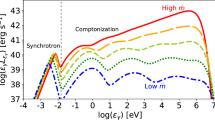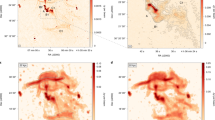Abstract
The radio source Sagittarius A* is thought to be powered by gas accreting onto a supermassive black hole at the centre of our Galaxy1,2. Using the high infrared accretion rates3, however, standard accretion models4 are unable to explain the observed low luminosity and spectral energy distribution5,6,7,8, which has led to the consideration of a new model: advection-dominated accretion flows9,10,11,12. In an advection-dominated flow, most of the accretion energy is stored as thermal energy in the gaswhich is then lost as the gas falls into the black hole. This model requires the protons to have a much higher temperature than the electrons, and the gas therefore has a two-temperature structure10,13,14. Although this model explains the low total luminosity15,16,17,18 and much of the spectral energy distribution (from millimetre wavelengths to hard X-rays), it has been difficult to reconcile with low-frequency radio observations. Here we show that a neglected emission process associated with the protons naturally explains the radio observations without any ‘fine tuning’ of the model parameters. This result simultaneously supports the two-temperature model of the gas and suggests that an advection-dominated accretion flow onto a black hole of 2.5 × 106 solar masses provides an accurate description of Sagittarius A*.
This is a preview of subscription content, access via your institution
Access options
Subscribe to this journal
Receive 51 print issues and online access
$199.00 per year
only $3.90 per issue
Buy this article
- Purchase on Springer Link
- Instant access to full article PDF
Prices may be subject to local taxes which are calculated during checkout


Similar content being viewed by others
References
Mezger, P. G., Duschl, W. J. & Zylka, R. The Galactic Center: a laboratory for AGN? Annu. Rev. Astron. Astrophys. 7, 289–388 (1996).
Genzel, R., Hollenbach, D. & Townes, C. H. The nucleus of our Galaxy. Rep. Prog. Phys. 57, 417–479 (1994).
Melia, F. An accreting black hole model for Sagittarius A*. Astrophys. J. 387, L25–L28 (1992).
Frank, J., King, A. & Raine, D. Accretion Power in Astrophysics (Cambridge Univ. Press, (1992).
Rogers, A. E. E. et al. Small-scale structure and position of Sagittarius A* from VLBI at 3 millimeter wavelength. Astrophys. J. 434, L59–L62 (1994).
Menten, K. M., Reid, M. J., Eckart, A. & Genzel, R. The position of Sagittarius A*: accurate alignment of the radio and infrared reference frames at the Galactic Center. Astrophys. J. 475, L111–L114 (1997).
Predehl, P. & Trümper, J. ROSAT observation of the Sgr A region. Astron. Astrophys. 290, L29–L32 (1994).
Merck, M. et al. Study of the spectral characteristics of unidentified galactic EGRET sources. Are they pulsar-like? Astron. Astrophys. Suppl. 120, 465–469 (1996).
Ichimaru, S. Bimodal behavior of accretion disks — Theory and application to Cygnus X-1 transitions. Astrophys. J. 214, 840–855 (1977).
Rees, M. J., Begelman, M. C., Blandford, R. D. & Phinney, E. S. Ion supported tori and the origin of radio jets. Nature 295, 17–21 (1982).
Narayan, R. & Yi, I. Advection-dominated accretion: underfed black holes and neutron stars. Astrophys. J. 452, 710–735 (1995).
Abramowicz, M. A., Chen, X., Kato, S., Lasota, J.-P. & Regev, O. Thermal equilibria of accretion disks. Astrophys. J. 438, L37–L39 (1995).
Shapiro, S. L., Lightman, A. P. & Eardley, D. M. Atwo-temperature accretion disk model for Cygnus X-1 — Structure and spectrum. Astrophys. J. 204, 187–199 (1976).
Phinney, E. S. in Plasma Astrophysics (eds Guyenne, T. D. & Levy, G.) 337–341 (SP-161, ESA, Paris, (1981)).
Rees, M. J. in The Galactic Center (eds Riegler, G. R. & Blandford, R. D.) 166–176 (Am. Inst. Phys., New York, (1982)).
Narayan, R., Yi, I. & Mahadevan, R. Explaining the spectrum of Sagittarius A* with a model of an accreting black hole. Nature 374, 623–625 (1995).
Manmoto, T., Mineshige, S. & Kusunose, M. Spectrum of optically thin advection-dominated accretion flow around a black hole: application to Sagittarius A*. Astrophys. J. 489, 791–803 (1997).
Narayan, R., Mahadevan, R., Grindlay, J. E., Popham, R. G. & Gammie, C. Advection-dominated accretion model of Sagittarius A*: evidence for a black hole at the Galactic Center. Astrophys. J. 492, 554–568 (1998).
Mahadevan, R., Narayan, R. & Krolik, J. Gamma-ray emission from advection-dominated accretion flows around black holes: application to the Galactic Center. Astrophys. J. 486, 268–275 (1977).
Mahadevan, R. Scaling laws for advection-dominated flows: applications to low-luminosity galactic nuclei. Astrophys. J. 477, 585–601 (1997).
Falcke, H. et al. The simultaneous spectrum of Sgr A* from λ20 cm to λ1 mm and the nature of the mm-excess. Astrophys. J.(in the press).
Backer, D. C. et al. Upper limit of 3.3 astronomical units to the diameter of the Galactic Center radio source Sgr A*. Science 262, 1414–1416 (1993).
Marcaide, J. M. et al. Position and morphology of the compact non-thermal radio source at the galactic center. Astron. Astrophys. 258, 295–301 (1992).
Alberdi, A. et al. VLBA image of Sgr A* at λ = 1.35 cm. Astron. Astrophys. 277, L1–L4 (1993).
Ginzburg, V. L. & Syrovatskii, S. I. The Origin of Cosmic Rays (Macmillan, New York, (1964)).
Dermer, C. D. Binary collision rates of relativistic thermal plasmas. II. Spectra. Astrophys. J. 307, 47–59 (1986).
Rybicki, G. & Lightman, A. Radiative Processes in Astrophysics (Wiley, New York, (1979)).
Begelman, M. C. & Chiueh, T. Thermal coupling of ions and electrons by collective effects in two-temperature accretion flows. Astrophys. J. 332, 872–890 (1988).
Quataert, E. Particle heating by Alfvenic turbulence in hot accretion flows. Astrophys. J.(in the press); also as preprint astro-ph/9710127 (1998).
Gruzinov, A. Radiative efficiency of collisionless accretion. Astrophys. J.(in the press); also as preprint astro-ph/9710132 (1998).
Blackman, E. Fermi energization in magnetized astrophysical flows. Phys. Rev. Lett.(in the press); also as preprint astro-ph/9710137 (1998).
Bisnovatyi-Kogan, G. S. & Lovelace, R. V. E. Influence of ohmic heating on advection-dominated accretion flows. Astrophys. J. 486, L43–L46 (1997).
Quataert, E. & Gruzinov, A. Turbulence and particle heating in advection-dominated accretion flows. Astrophys. J.(submitted); also as preprint astro-ph/9803112 (1998).
Narayan, R., Mahadevan, R. & Quataert, E. Advection dominated accretion around black holesin The Theory of Black Hole Accretion Discs(eds Abramovicz, M. A., Bjornsson, G. & Pringle, J. E.) (Cambridge Univ. Press, in the press).
Duschl, W. J. & Lesch, H. The spectrum of Sgr A* and its variability. Astron. Astrophys. 286, 431–436 (1994).
Falcke, H. in Unsolved Problems in the Milky Way (eds Blitz, L. & Teuben, P. J.) 163–170 (IAU Symp. No. 169, Kluwer, Dordrecht, (1996)).
Beckert, T. & Duschl, W. J. Synchrotron radiation from quasi-monoenergetic electrons. Modeling the spectrum of Sgr A*. Astron. Astrophys. 328, 95–106 (1997).
Mastichiadis, A. & Ozernoy, L. M. X-ray and gamma-ray emission of Sagittarius A* as a wind-accreting black hole. Astron. Astrophys. 426, 599–603 (1994).
Melia, F. An accreting black hole model for Sagittarius A*. 2: A detailed study. Astrophys. J. 426, 577–585 (1994).
Mahadevan, R., Narayan, R. & Yi, I. Harmony in electrons: cyclotron and synchrotron emission by thermal electrons in a magnetic field. Astrophys. J. 465, 327–337 (1996).
Shakura, N. I. & Sunyaev, R. A. Black holes in binary systems. Observational appearance. Astron. Astrophys. 24, 337–355 (1973).
Haller, J. et al. Stellar kinematics and the black hole in the Galactic Center. Astrophys. J. 456, 194–205 (1996); Erratum. Astrophys. J. 468, 955 (1996).
Eckart, A. & Genzel, R. Stellar proper motions in the central 0.1 pc of the Galaxy. Mon. Not. R. Astron. Soc. 284, 576–598 (1997).
Acknowledgements
I thank R. Narayan, E. Blackman, A. Fabian, C. Gammie, Z. Haiman, J. Herrnstein, J.Krolik, A. Mody, M. Rees and E. Quataert for discussions and comments.
Author information
Authors and Affiliations
Corresponding author
Rights and permissions
About this article
Cite this article
Mahadevan, R. Reconciling the spectrum of Sagittarius A* with a two-temperature plasma model. Nature 394, 651–653 (1998). https://doi.org/10.1038/29241
Received:
Accepted:
Issue Date:
DOI: https://doi.org/10.1038/29241
This article is cited by
-
Computational evaluation of anticipated PE_PGRS39 protein involvement in host–pathogen interplay and its integration into vaccine development
3 Biotech (2021)
-
A cool accretion disk around the Galactic Centre black hole
Nature (2019)
-
Structure of relativistic accretion disk with non-standard model
Astrophysics and Space Science (2016)
-
Modelling Spectral and Timing Properties of Accreting Black Holes: The Hybrid Hot Flow Paradigm
Space Science Reviews (2014)
Comments
By submitting a comment you agree to abide by our Terms and Community Guidelines. If you find something abusive or that does not comply with our terms or guidelines please flag it as inappropriate.



